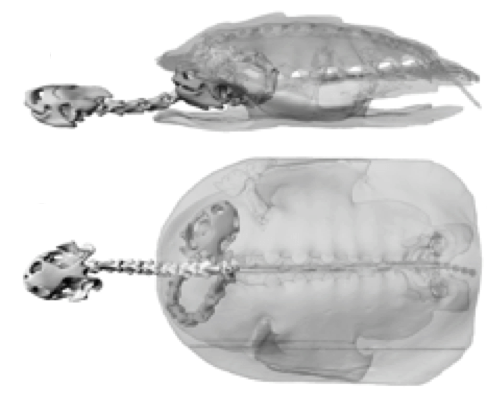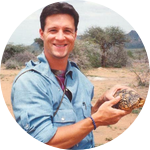About This Project
With an unusually shelled body, turtles are perhaps one of the most easily recognizable and enigmatic animals. Yet we know little about how the shell diversified during their rich 220-million year history. The shell-closing system of box turtles exemplifies the potential to undergo unprecedented evolutionary change. My project aims to, for the first time, employ 3D reconstruction techniques to visualise innovations that enable shell-closure - a key adaptation in turtle evolution.
Ask the Scientists
Join The DiscussionWhat is the context of this research?
Turtles come in freshwater, marine, and terrestrial flavors and are found in most oceans and continents of the world. This ecological diversification is reflected in the remarkable shell variation of species, suggesting that form and function of the turtle body plan has evolved in a unique manner. For instance, box turtles feature an extraordinary “drawbridge” shell-closing system with functional and anatomical components that are unusual among vertebrate animals. Thus, details on how it exactly functions remain elusive. Anatomists hypothesized that shell movement is enabled by an intricate shoulder blade articulation and contraction of powerful neck and shoulder muscles. Altogether, this pulley-and-lever mechanism enables the turtle to conceal all extremities during predator attacks.
What is the significance of this project?
Turtles are one of the most recognisable and enigmatic groups of animals. Although they are one of Earth's most successful reptiles since their appearance in the fossil record at least 210 million years ago, they are rapidly declining due to human activity. To inspire awareness, I strive to discover patterns and processes of turtle diversity. For example, research on box turtles may teach us that novel and highly complex forms do not necessarily limit the capacity for organisms to diversify. The shell-closing systems of box turtles is a prime example of this. Examining this functional innovation could reveal surprises on the processes that give rise to the skeletal system of vertebrate animals in general, while emphasising the urgent need to sustain turtle diversity for years to come.
What are the goals of the project?
Your contributions will enable me to test the hypothesis that skeletal and muscle adaptations in box turtles comprise a pulley-and-lever system enabling shell closure in a manner akin to a castle's drawbridge. This requires comparison of turtles with and without shell-closing systems. Thus, I plan to purchase eight turtles representing lineages with and without shell-closing systems (listed in budget below). My goal is to (for the first time) employ non-invasive state-of-the-art imaging techniques to visualise and compare neck and limb bone components inside the shell (see below). Based on 3D X-ray reconstructions, I will generate movies depicting shell closure biomechanics in box turtles. This requires travel to institutions in Germany. Your kind donations are needed to achieve this!
Budget
Requested funds for the listed budget items would be very helpful in completing key research objectives of project. For the project to succeed, I need to purchase, eight experimental animals, each representing a distinct evolutionary lineage. Turtles with shell-closing systems will be represented by species fromTerrapene, Sternotherus, and Pelusios. Turtles without, by: Emydura, Trachemys, Pelodiscus, Testudo, and Pelomedusa.
Secondly, I will need to travel to imaging facilities in Jena (Institut für Spezielle Zoologie und Evolutionsbiologie) and Berlin (Museum für Naturkunde in Germany) where I will collect and process most of the data (we are making cool animations!). Travel expenses are for air and ground transportation within Germany. At the moment, I do not have external funding to cover these expenses. To successfully complete our project, we must travel to use equipment only available in these institutions.
Endorsed by
Meet the Team
Ingmar Werneburg
Since 2016. Curator of the Palaeontological Collection and Lecturer of Zoomorphology in Tübingen / Germany
2015. Swiss National Science Foundation postdoctoral researcher, host: Museum für Naturkunde Berlin / Germany (associated to the N. Fröbisch-lab)
2013-2014. Postdoctoral researcher, Paläontologisches Institut und Museum der Universität Zürich / Switzerland (Sánchez-lab): "Mammalian and reptilian embryology" (50% position)
2012-2013. Postdoctoral researcher, Geowissenschaften Universität Tübingen / Germany (Joyce-lab): "Turtle neck evolution"; incl. parental leave
2011. Postdoctoral researcher, RIKEN, Center for Developmental Biology Kobe / Japan (Kuratani-lab): "Amniote skull development"
2010-2011. Postdoctoral researcher, Paläontologisches Institut und Museum der Universität Zürich / Switzerland (Sánchez-lab): "Mammalian embryology"
Additional Information
This is an example of 3D reconstructions we wish to generate with your help. The goal is to compare anatomical details but also to create animations that bring to life the biomechanics of turtles with and without shell-closing systems. This is the first attempt to make the comparison. 
Project Backers
- 6Backers
- 22%Funded
- $275Total Donations
- $45.83Average Donation


